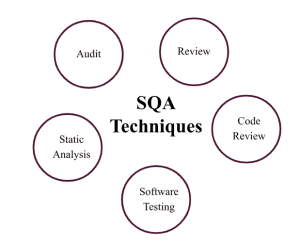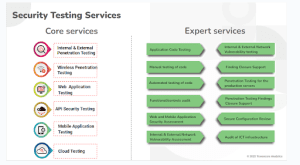
AUTHOR,
Amrutha U

AUTHOR,
Saleena Davood A
With society becoming increasingly digitally integrated, software now has a far greater impact. It advances business opportunities, raises living standards, and creates a more intelligent society. In addition to these, today software plays critical roles across all the walkways of common people. However, all it requires is the smooth and fail-proof functioning of the software. Software quality assurance facilitates the production of software of the highest caliber. Comparable to a quality guardian is quality assurance. This process is like having someone watch over every step of making the software, from writing the code to testing it. Software testing is a very important part of software quality assurance. Now we can look into the software testing approach at TA and how to ensure excellence in QA.
Maximizing Software Quality Assurance Efficiency
The quality assurance team of a software development project will collaborate with a solution architect to analyze requirements right from the project commencement, establish the variables that identify whether the solution satisfies their goals, and develop a series of testing procedures. These are then utilized to guarantee that the customer receives exactly what they want. The quality assurance team will also oversee the implementation of these testing procedures and undertake testing to make sure that everything is running properly and without errors.
Roles and activities that SQAs are involved in:
— Ensuring that the software quality is in line with the specifications and business needs.
— Take care of defect prevention and create formal methods for more potent ways to prevent defects.
— Project testing for failure detection and bug fixing
— Identification of underlying potential threats
— Implement techniques and procedures for tracking problems.
SQA Techniques
Here are some SQA techniques that are implemented in TA,
 1. Audit:
1. Audit:
There is a set of predefined questions based on the type of the project for doing the audit. Projects are audited every 2 weeks. If there are any non-compliance observed, then it will be reported to the senior management and the audit process is repeated after 1 week for those items to ensure that they are resolved. This is done by the Quality Assurance team, and it helps to assess the software development activities against defined standards in order to see the gap and act accordingly.
2. Review:
Stakeholders, Project Lead and the QA member meets to analyze the health of the project. In this meeting the flaws in the process side, bugs, code quality etc. will be discussed.
3. Code Review:
Git Flow is followed to ensure that the code is getting reviewed before merging. In addition to this, there will be a code review session every two weeks and the experts in the technologies review the code and give comments. These comments will be resolved by the developers.
4. Software Testing:
The quality assurance team member verifies whether the application behaves in the exact way that it is supposed to do.
5. Static Analysis:
For static analysis of the code, we are using the tool SonarQube. All the bugs, vulnerabilities and unclean code will be captured by this tool and the developers resolve those issues. Quality Gateway is built into the project pipeline, and it will prevent building the code if there is any poor-quality code.
The Process of Software Testing in Practice
We at TA follow the three major steps in the software testing process: Planning, Execution, and Reporting.

As any other formal process, testing activities are typically preceded by thorough preparations and planning. In the planning phase, we do a detailed study of the requirements to get more knowledge about the software. Once this is done, the QA person will prepare the Test Strategy and Test Plan documents.
After preparing the test strategy and plan, we will start the development of the test cases based on the requirements. A test case describes the preconditions, desired outcomes, and postconditions of a specific test scenario, aimed at verifying that a feature meets the basic requirements. For the software’s that requires automation testing, the script development activities will also be carried out. Once the test cases/scripts are ready, QA will start the execution of the cases/scripts. Bugs found during the execution will be logged in the project management tool.
After the completion of the test execution, Test Result Document will be shared to the team specifying whether the software can be released or not based on the bug count and priority. The test execution process repeats until all the bugs get fixed.
The Levels of Software Testing in Practice
The structural quality of the software relies mostly on the expertise of the engineering team and is assured through code review, analysis and refactoring. At the same time, functional aspects are assured through a set of dedicated quality management activities, which includes quality assurance, quality control, and testing.
We at TA follow the below levels of testing: Unit Testing, Integration Testing, and System Testing.

Unit testing is done in order to make sure that it meets the original requirements and functions as expected and it is commonly performed early in the development process by the engineers themselves.
The next level of testing done is the integration testing to detect the flaws in interaction between different modules. Test cases to verify the functionality of individual modules and the interaction between different modules are executed at this level. After the successful completion of the integration testing, the next step is to do the system testing. In system testing we check whether the overall functionality of the system fulfills the business requirements. For checking this, we execute the end-to-end test cases and record the results. Both integration testing and system testing are done by the QA team.
The Types of Software Testing in Practice
We at TA follow the below types of testing: Functional Testing and Non-functional Testing.
Functional Testing
Functional testing verifies that the application satisfies the requirements or specifications correctly. By giving the proper test input, anticipating the result, and contrasting the actual output with the expected output, each software application capability is tested. Projects used to perform different functional testing such as Unit Testing, Smoke Testing, Integration Testing, Regression Testing, User Acceptance Testing, etc.
Every project in TA undergoes functional testing through Developers (Developer Testing) and dedicated testers (QA Testing) which is a standard process followed within the organization.
When manual testing results in high maintenance costs, an automated solution ensures faster productivity with minimal capital investments. Automation testing team here is open to take you along with the wonders of automation in different platforms and languages. We are practicing automation using our internal framework as well as different external frameworks such as Carina, FlaUI, etc. Our quality team is handling different types of applications such as web, desktop and mobile applications.
We have an example of Automating an Online Training Platform for which our Team has automated all the possible Regression Test cases using Carina framework which are integrated to the CI/CD pipeline. Similar test automation scripts generated using the Carina framework are currently executed on a daily basis for a Fire Evacuation Management Platform.
Non-functional Testing
The purpose of non-functional testing is to examine non-functional features of a software program. Security Testing and Performance Testing are the non-functional testing performed in TA.
Security testing finds the system’s weak points and establishes whether the system’s resources and data are safe from potential hackers. Our team is expertise in the area of Security Testing using the tools such as Burp Suite, OWASP ZAP, Nessus, etc.

Product performance is a critical component that needs to be given attention right at the design stage. TA’s goal is to ensure your product performance is consistent with normal as well as extreme load conditions. Professionals here have already initiated the performance testing of different applications in different domains using JMeter.
One primary example is, we have successfully done the performance testing of a logistics web application with a maximum load of 1000 users. The script was executed in a dedicated machine on the Customer side. Analyzed the CPU Utilization and the Response Time of the requests in different scenarios. Based on the analysis, Customer has found out the APIs and queries that causes maximum resource waiting and done query tuning and API logical changes and improved the performance of the application successfully.
Also, we have successfully done the performance testing of a SignalR based quiz application using JMeter.
Principles of Software Testing Followed in TA
1. Early Testing to Reduce Error Costs:
As the Software Development Life Cycle (SDLC) progresses through its stages, an error’s cost increases exponentially. Therefore, it’s critical to start testing the software as soon as possible to detect and resolve issues before they escalate.
2. Customized Testing for Different Applications:
Depending on their purpose or industry, different applications are tested differently.
3. Independent Testing:
Testing should be conducted as an independent process, managed by unbiased professionals.
4. Comprehensive Input Testing:
Test for invalid and unexpected input values as well as valid and expected ones.
5. Testing on Static Software:
Testing is performed only on a static piece of software, and no changes should be made during the testing process.
6. Detailed Documentation for Test Outcomes:
To specify the desired test outcomes, use thorough and detailed documentation.
Despite a widespread misbelief that a tester’s only task is to find bugs, testing and quality assurance have a greater impact on the success of the final product. Gaining a deep understanding of the client’s business and the product itself, our QA engineers add value to the software and ensure its excellent quality.
